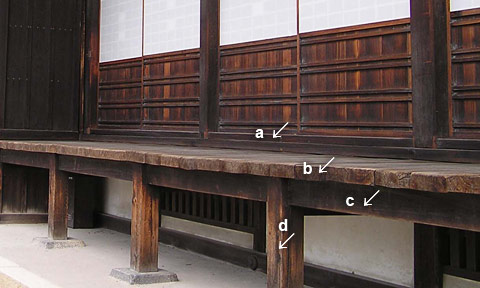|
||
 |
||

@
(C)2001 Japanese Architecture and Art Net Users System.@No reproduction or republication without written permission.
fÚÌeLXgEÊ^ECXgÈÇASÄÌRec̳f¡»E]ÚðֶܷB
|
||||||
| @ | ||||||
| en-ita@Â | ||||||
| KEY WORD :@architecture / general terms | ||||||
| @ | ||||||
| The boards used to make the floor over a veranda framework. There are two common methods: kirime-en ØÚ and kure-en Ò. Kirime-en uses short cross-cut planks that are placed at right angles to the direction of the ridge. They extend from the wall or the lower sliding door tracks *shikii ~ to just beyond the supporting veranda strut-ties *enkazura that tie the veranda struts *enbashira together. The outer cut ends are usually exposed. Kure-en uses long planks that run parallel to the direction of the ridge. Their cut ends appear at each end of the veranda. More rarely, the veranda boards are cut on the diagonal, making a more elaborate looking floor surface. The planks are set with an almost imperceptible incline so that rainwater can easily run off. | ||||||
| @ | ||||||
 |
||||||
@ |
||||||
| REFERENCES: | ||||||
| *nure-en G | ||||||
| EXTERNAL LINKS: | ||||||
| @@ | ||||||
| NOTES: | ||||||
| @ | ||||||
(C)2001 Japanese Architecture and Art Net Users System.@No reproduction or republication without written permission. fÚÌeLXgEÊ^ECXgÈÇASÄÌRec̳f¡»E]ÚðֶܷB |
||||||
| @ |